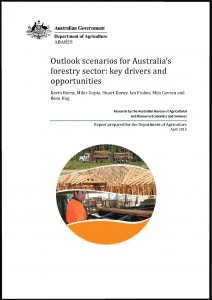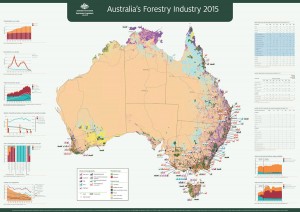Two major information pieces were released this week that that provide reliable information on Australian forestry. Source: Timberbiz
The first is Australia’s Forestry Industry 2015 map that shows a detailed snapshot of the forestry industry, including the location of major wood processing facilities, native forest tenure, hardwood and softwood plantations, as well as roads and forestry ports.
The map also includes information on sawmills, employment, historical and projected national sawlog availability, the areas under forest or plantation and new plantation area by planting year.
It presents valuable resource information in a simple and easy to understand way that can assist in planning, scoping regional industry and development opportunities.
The map can be downloaded at http://data.daff.gov.au/anrdl/metadata_files/pb_ausfim9abfe20150414_11a.xml
Secondly, ABARES released its report titled: Outlook scenarios for Australia’s forestry sector: key drivers and opportunities.
This report examines three potential outlook scenarios for Australia’s forestry sector using analysis of the potential availability and use of logs, forecasts of wood product consumption, and the opportunities for processing of wood products and investment.
ABARES conducted a number of workshops with industry and government stakeholders to refine the scenarios and test the assumptions supporting this analysis.
A business-as-usual scenario was analysed, which depicts a future assuming current economic, policy and environmental factors affecting the forestry sector remain unchanged over the projection period (to 2050).
Two alternative scenarios (priority-to-productivity and constrained-wood-production) are also examined. Sensitivity testing was also conducted to identify the influence of key parameters.
The analysis in this report highlights key opportunities for Australia’s forestry sector, as well as the economic and policy factors required for realising these opportunities. The results affirm that a positive investment environment for upgrading and expanding wood processing infrastructure will underpin growth in Australia’s forestry sector.
Australia’s forestry sector has changed significantly over recent decades in response to a range of environmental, market and policy challenges. These changes have resulted in a diverse domestic sector characterised by several forest regions with different forest types, an array of processing technologies and reliance on both domestic and international markets.
Forest product markets are dynamic, and Australia’s forestry sector will continue to adapt to varying economic, environmental and policy factors over the longer term.
In November 2012 ABARES was commissioned by the Department of Agriculture to examine the future of the Australian forestry sector and to investigate likely wood demand and supply scenarios over the period to 2050.
In this report, ABARES describes three outlook scenarios for Australia’s forestry sector and analyses the estimated availability and use of logs, opportunities for investment and primary processing of wood products, and the importance of factors affecting these outlooks from 2011‒12 conditions to 2050.
The scenarios are:
- business-as-usual
- priority-to-productivity
- constrained-wood-production.
The business-as-usual scenario depicts a future without major changes from present conditions – that is, current economic, policy and environmental parameters are assumed to remain unchanged and current trends to continue.
The priority-to-productivity and constrained-wood-production scenarios present alternative trajectories for the forestry sector based on different sets of policy, market and supply assumptions.
The analysis presented in this report illustrates the broad trends and key parameters that will shape Australia’s forest industry over the longer term. However, several issues are outside the scope of the present analysis.
This report is available to download at http://data.daff.gov.au/data/warehouse/9aaf/9aafe/2015/OutlookAustForSect/outlookAustForSectKeyDrive201504_v1.0.0.pdf







